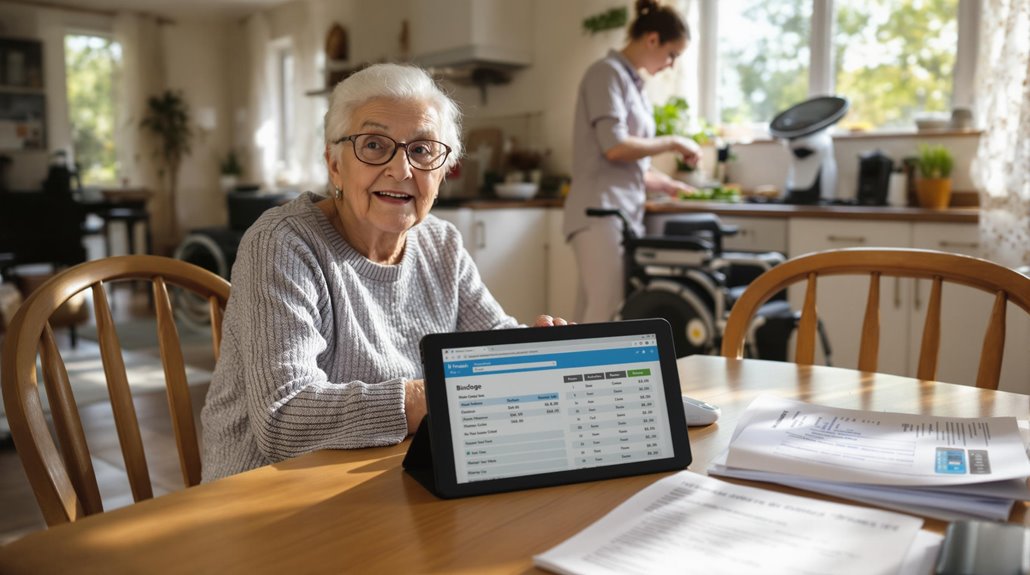You'll find home care services in 2025 typically cost between $25 and $35 per hour, though rates vary based on your location and care needs. Companion care starts at $20 per hour, while personal care services range from $25 to $40 hourly. You'll pay more in states like Alaska ($35-$45) and less in southern states like Mississippi ($18-$25). Understanding your specific care requirements and location will help you uncover the most accurate cost estimates for your situation.
Understanding the Core Factors Behind 2025 Home Care Pricing
While managing the complexities of home care costs can feel overwhelming, understanding the core factors that influence 2025 pricing will help you make informed decisions.
The average hourly cost for home care services ranges from $25 to $35, varying based on caregiver qualifications and service type. You'll find companion care at $20-$30 per hour, while personal care services cost between $25-$40 hourly.
Geographic location greatly impacts pricing, with states like Alaska and California commanding higher rates of $35-$45 per hour. If you're considering skilled nursing care, expect to pay $50-$80 hourly for licensed professionals.
Remember to factor in additional fees for emergency care services, which can increase costs by 20-30%, along with premium charges for weekend and holiday coverage. Understanding these financial implications helps you plan effectively for your loved one's care.
Breaking Down Hourly Rates Across Service Types
As you explore home care options in 2025, you'll encounter distinct pricing tiers based on the level of care needed. The national median cost for non-medical in-home care stands at $28.41 per hour, though rates vary by service type.
Companion care services start at the lower end, ranging from $20 to $30 hourly for basic assistance and light housekeeping.
When you need personal care assistance for tasks like bathing or mobility support, expect to pay between $25 to $40 per hour.
Specialized care for conditions such as dementia requires additional caregiver training, reflecting higher hourly rates of $30 to $50.
For medical services, skilled nursing care represents the highest tier, with hourly rates spanning $50 to $80, delivered by licensed nursing professionals.
State-by-State Cost Analysis and Regional Variations
Location plays a major role in determining your home care costs for 2025, with stark differences between states and regions. While the national median cost for non-medical home care sits at $28.41 per hour, you'll find significant regional variations driven by local living expenses and caregiver availability. Urban areas typically command 20-30% higher rates than rural locations due to increased demand and service complexity.
| State | Hourly Rate Range |
|---|---|
| Alaska | $35-$45 |
| Hawaii | $34-$42 |
| Florida | $25-$33 |
| Texas | $24-$31 |
| Mississippi | $18-$25 |
Understanding your state's cost landscape helps you plan effectively for care needs. While Alaska and Hawaii top the charts with the highest rates, you'll find more affordable options in southern states like Mississippi and Arkansas, where rates remain considerably lower.
Financial Planning Options for Home Care Services
Several financial planning options can help you manage the rising costs of home care services in 2025. When planning for future care, you'll want to explore long-term care insurance, which costs about $2,050 annually for couples aged 55, offering substantial coverage for home health services.
Medicaid remains the primary financial assistance source, contributing $230 billion toward senior care, though eligibility requirements vary by state.
Consider these key strategies for managing home care costs:
- Research local nonprofits that provide subsidized care options or financial aid
- Explore veterans benefits if you or your spouse served in the military
- Create a dedicated savings plan while investigating long-term care insurance coverage
Understanding these care options early helps guarantee you'll have adequate resources when you need them most.
Technology's Impact on Modern Home Care Expenses
Technology innovations in home care services are revolutionizing cost structures for seniors and their families in 2025.
You'll find that technology's impact on home care costs is substantial, with monthly healthcare expenses dropping by approximately $425 per person through smart home implementations.
Remote monitoring systems are transforming care delivery while preserving seniors' independence.
You'll see an 11% reduction in emergency room visits and 25% fewer hospital admissions, making home care services more affordable.
Digital health records in assisted living facilities optimize operational costs through improved efficiency.
The financial benefits are clear – you can expect annual savings of up to $506 per person by embracing these technological advances.
This shift in care delivery not only enhances the quality of service but also makes long-term care more sustainable for your loved ones.
Comparing Home Care With Alternative Care Solutions
When evaluating senior care options in 2025, you'll find significant cost differences between home care services and traditional facilities. Home care costs range from $25 to $35 per hour, offering flexibility and personalized care that can save your family money compared to fixed-rate alternatives.
Consider these key financial comparisons:
- Assisted living facilities average $5,511 monthly for a private room, while part-time home health services can cost less for basic assistance.
- Nursing homes charge approximately $9,653 monthly for private rooms, making home care a more economical choice for many families.
- Home care's pay-for-what-you-need model provides financial benefits, especially when your loved one requires limited support.
You'll also discover that home care promotes independence by allowing seniors to remain in familiar surroundings while receiving customized support based on their specific needs.
Future Trends Shaping Home Care Costs Through 2030
Looking ahead to 2030, the home care industry faces major cost increases that will reshape how families plan for long-term care.
You'll need to prepare for home health care costs potentially doubling to $226 billion, with an average annual increase exceeding 7% through 2029.
The financial strain on families will intensify as consumer out-of-pocket expenses for home care could surge to over $27 billion.
The aging population's growing needs, combined with caregiving workforce shortages, will drive home care rates up to $30 or more per hour.
The total value of long-term care services may reach up to $2.50 trillion by 2030.
To guarantee future care remains accessible, you'll want to start planning now for the affordability of home care, considering these projected increases in service costs.
Conclusion
Home care costs in 2025 will hit your wallet like a tidal wave if you're not prepared. You'll need to weigh hourly rates against thorough care packages, consider your state's specific pricing, and explore financial aid options. While technology's bringing some cost-saving solutions, early planning remains essential. By understanding these factors and staying informed about industry trends, you'll navigate the home care landscape more confidently.




